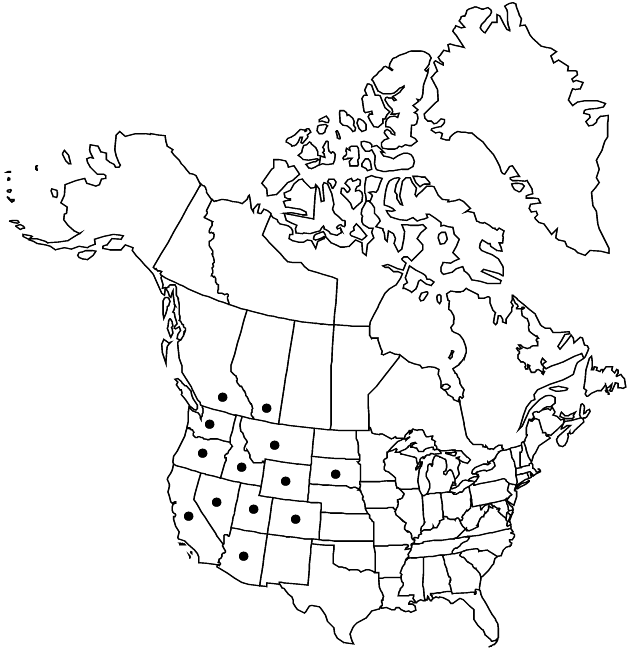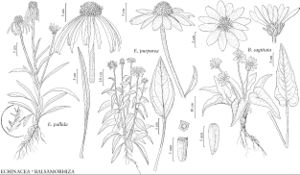Difference between revisions of "Balsamorhiza sagittata"
Trans. Amer. Philos. Soc., n. s. 7: 350. 1840.
FNA>Volume Importer |
imported>Volume Importer |
||
| (5 intermediate revisions by 2 users not shown) | |||
| Line 7: | Line 7: | ||
|year=1840 | |year=1840 | ||
}} | }} | ||
| − | |basionyms={{Treatment/ID/ | + | |special_status={{Treatment/ID/Special_status |
| + | |code=F | ||
| + | |label=Illustrated | ||
| + | }}{{Treatment/ID/Special_status | ||
| + | |code=E | ||
| + | |label=Endemic | ||
| + | }} | ||
| + | |basionyms={{Treatment/ID/Basionym | ||
|name=Buphthalmum sagittatum | |name=Buphthalmum sagittatum | ||
|authority=Pursh | |authority=Pursh | ||
| + | |rank=species | ||
| + | |publication_title=Fl. Amer. Sept. | ||
| + | |publication_place=2: 564. 1813 | ||
}} | }} | ||
|synonyms={{Treatment/ID/Synonym | |synonyms={{Treatment/ID/Synonym | ||
|name=Balsamorhiza helianthoides | |name=Balsamorhiza helianthoides | ||
|authority=(Nuttall) Nuttall | |authority=(Nuttall) Nuttall | ||
| + | |rank=species | ||
}} {{Treatment/ID/Synonym | }} {{Treatment/ID/Synonym | ||
|name=Espeletia helianthoides | |name=Espeletia helianthoides | ||
|authority=Nuttall | |authority=Nuttall | ||
| + | |rank=species | ||
}} {{Treatment/ID/Synonym | }} {{Treatment/ID/Synonym | ||
|name=Espeletia sagittata | |name=Espeletia sagittata | ||
|authority=(Pursh) Nuttall | |authority=(Pursh) Nuttall | ||
| + | |rank=species | ||
}} | }} | ||
|hierarchy=Asteraceae;Asteraceae tribe Heliantheae;Asteraceae (tribe Heliantheae) subtribe Ecliptinae;Balsamorhiza;Balsamorhiza subg. Artorhiza;Balsamorhiza sagittata | |hierarchy=Asteraceae;Asteraceae tribe Heliantheae;Asteraceae (tribe Heliantheae) subtribe Ecliptinae;Balsamorhiza;Balsamorhiza subg. Artorhiza;Balsamorhiza sagittata | ||
| Line 44: | Line 57: | ||
-->{{#Taxon: | -->{{#Taxon: | ||
name=Balsamorhiza sagittata | name=Balsamorhiza sagittata | ||
| − | |||
|authority=(Pursh) Nuttall | |authority=(Pursh) Nuttall | ||
|rank=species | |rank=species | ||
| Line 58: | Line 70: | ||
|publication title=Trans. Amer. Philos. Soc., n. s. | |publication title=Trans. Amer. Philos. Soc., n. s. | ||
|publication year=1840 | |publication year=1840 | ||
| − | |special status= | + | |special status=Illustrated;Endemic |
| − | |source xml=https:// | + | |source xml=https://bitbucket.org/aafc-mbb/fna-data-curation/src/2e0870ddd59836b60bcf96646a41e87ea5a5943a/coarse_grained_fna_xml/V19-20-21/V21_219.xml |
|tribe=Asteraceae tribe Heliantheae | |tribe=Asteraceae tribe Heliantheae | ||
|subtribe=Asteraceae (tribe Heliantheae) subtribe Ecliptinae | |subtribe=Asteraceae (tribe Heliantheae) subtribe Ecliptinae | ||
Latest revision as of 20:10, 5 November 2020
Plants (15–)20–40(–65) cm. Basal leaves: blades ± silvery to white or gray-green, rounded-deltate or deltate to triangular-deltate, 5–25 × 3–15 cm, bases ± cordate, margins entire, apices acute to attenuate, faces sericeous, tomentose, tomentulose, or velutinous (at least abaxially, usually gland-dotted as well), sometimes glabrescent. Heads usually borne singly, sometimes 2–3+. Involucres hemispheric to turbinate, 12–25 mm diam. Outer phyllaries lanceolate to oblanceolate or linear, (15–)20–25(–30+) mm, equaling or surpassing inner, apices acute to acuminate. Ray laminae 20–40 mm. 2n = 38.
Phenology: Flowering (Apr–)May–Jun(–Jul).
Habitat: Openings, banks, flats, meadows, ridges, sagebrush scrub, conifer forests
Elevation: (100–)900–2500(–3000) m
Distribution

Alta., B.C., Ariz., Calif., Colo., Idaho, Mont., Nev., Oreg., S.Dak., Utah, Wash., Wyo.
Discussion
Balsamorhiza sagittata grows east of the Cascade-Sierra axis to the Rocky Mountains and Black Hills. It is one of the more spectacular of all spring-flowering plants in the northwestern United States. Hybrids occur along lines of contact between B. sagittata and almost all species of sect. Balsamorhiza except B. macrophylla (a high polyploid).
Selected References
None.
